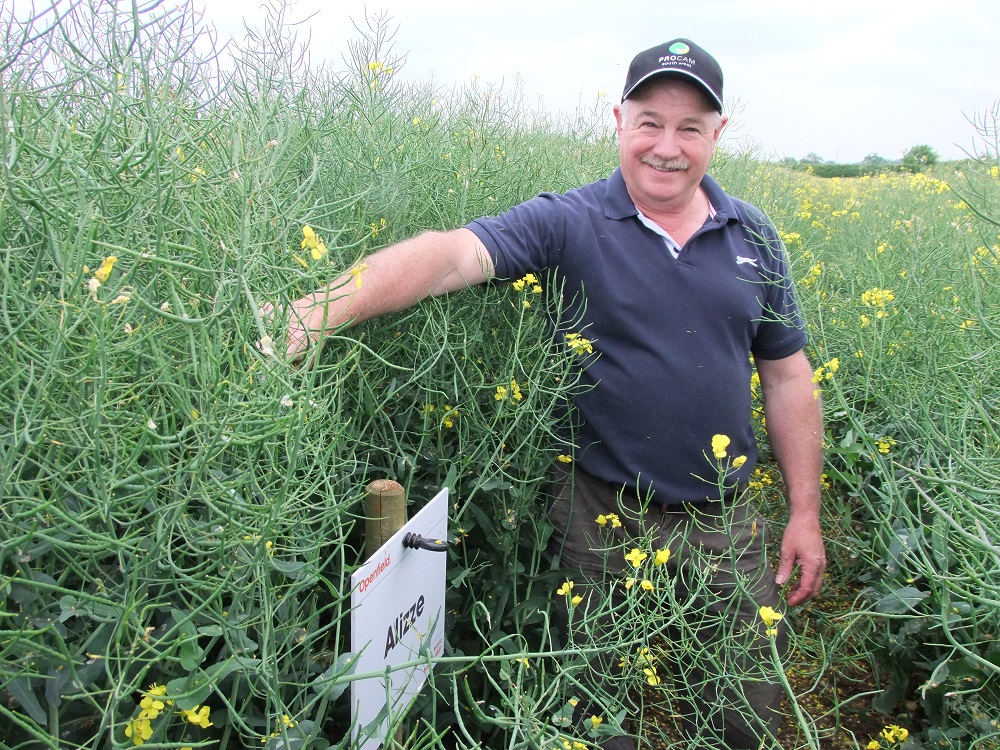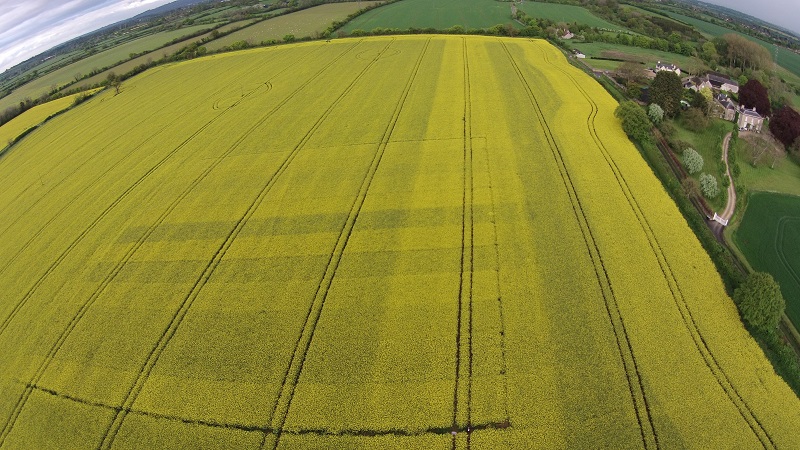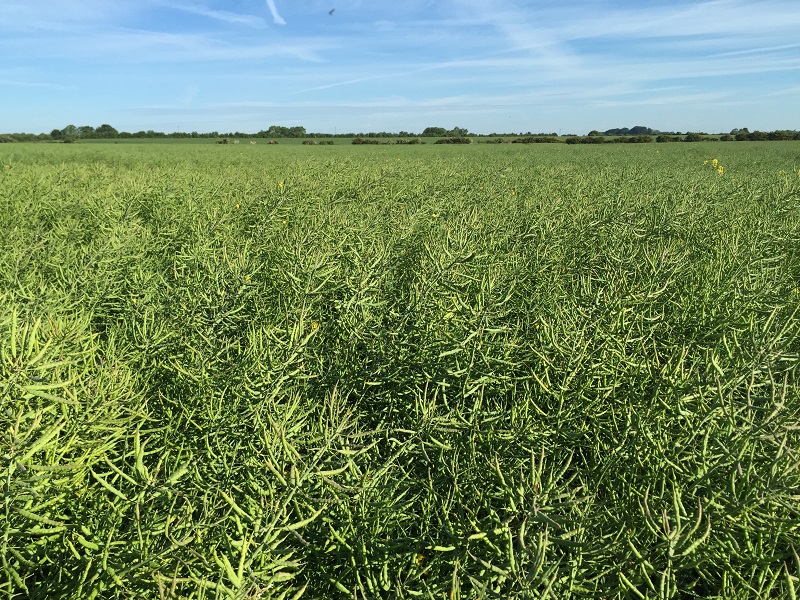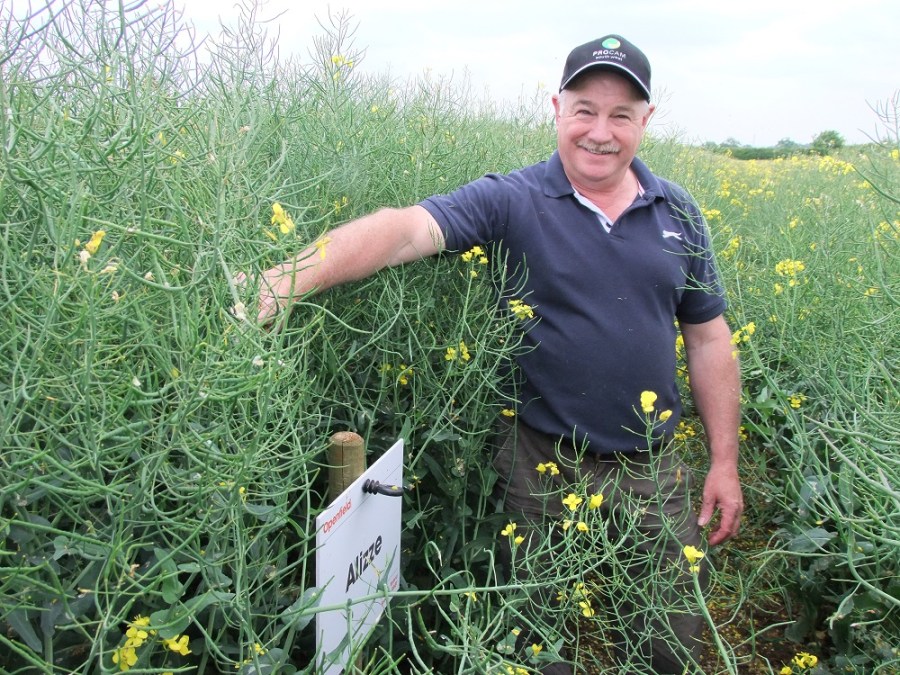
While Cereals may be the Mecca for arable farmers, when it comes to impartial observations and thoughts on up and coming varieties, there’s a farm manager in Wilts who’s ahead of the game. CPM pays him a visit.
I wanted to find out which varieties suit our soil types, our way of farming and the chemistry that we may apply.
By Lucy de la Pasture
Martin Smart is a self-confessed oilseed rape enthusiast, who likens his approach to his crops as similar to a stockman – it’s about attention to detail. His enthusiasm is infectious and after a visit to his trials, it would be difficult to be pessimistic about the future of OSR in the rotation.
With around 400ha of OSR under his wing, he has holdings with a range of soil types from heavy clay to free-draining Cotswold brash and chalks with flints. He currently has commercial blocks of Alizze, DK Extrovert, Incentive, DK Expower, DK Excellium, Campus, SY Harnas and HOLL variety V316 OL scattered around the county.
On meeting Martin, it’s obvious he has an enquiring mind – ‘what if’s’ and ‘why’ are questions he’s always asking about different varieties and their agronomy on his farms. In 2003, the contract farming business he manages expanded significantly to incorporate seven holdings. In order to answer some of the burning questions about which varieties to grow, he expanded his existing trial programme to 15 OSR varieties to see them for himself.
“It all started after I went to Germany with Openfield and DSV and met some of the breeding guys and I was just blown away by their enthusiasm. We went out to their trial site and when I questioned them about the characteristics of different varieties, they could just reel off the answers.
“So I thought if I could put trials like that on my farm, and work with the seed breeders to try new varieties not yet on the market, then I would gain more knowledge,” he explains.
“I wanted to find out which varieties suit our soil types, our way of farming and the chemistry that we may apply. From the trials, we can identify differences in how they react when planted using our system and other details, like how waxy they are,” he says.
The difference between conventional varieties (left) and hybrids become clear when you lie under the canopy and look up – there’s more light penetration to the lower branches of the hybrid due to a lower plant population.
Waxiness is something that varies significantly between varieties and needs to be taken into account when chemistry that can be aggressive needs to be applied, particularly to control weeds, believes Martin Smart.
Herbicide sensitivity
“We have charlock in some fields and use Fox (bifenox) to control it. Where there’s blackgrass, Centurion Max (clethodim) may be necessary and both products can be hot if the variety isn’t waxy enough at the time of application. The trials provide an insight to how sensitive different varieties are,” he says, adding that’s the sort of information that’s important in practice but hard to come by when looking at new varieties.
The variety demo hosts farmer days in autumn and spring in conjunctions with CF Fertilisers, Openfield and Syngenta. “The feedback I get is that growers like it because it’s unbiased. I look at the demos all the time and give my observations but I’m not marketing anything,” he says. “Many growers are guided by their agronomists to grow a variety that they have available to them, which may not be the best variety to suit their actual situation.”
Plots are ‘farmer style’ according to Martin Smart – 120m long and 12m wide to allow a full cutter width to be taken from each with his 10.5m Claas Lexion combine. Hybrids are drilled at a seed rate of 50 seeds/m² and conventional varieties at 100 seeds/m².

It’s easy to pick out the Toprex tramline – crops looked as if they’d been painted yellow with a paintbrush.
Agronomically, they’re all treated the same. For the past three seasons season, he’s used the new PGR from Syngenta, Toprex (paclobutrazol+ difenoconazole) and there have been startling differences between varieties in height reduction.
“In some varieties the effect of Toprex has been more than in others. For some of the taller varieties, such as DK Exclaim, Dariot and DK Extrovert, Toprex hasn’t been man enough for the job, not taking much height out of them. These taller varieties really seem to need metconazole to peg them back,” he says.
“But what Toprex has done brilliantly is to even up the flowering. Crops looked as if they’d been painted yellow with a paintbrush when I flew the drone over them about 10 days after application!”
And it’s that sort of information that Martin Smart is gleaning from his trials that’s so useful. “Some varieties are growth regulated too aggressively by metconazole, in which case Toprex would be ideal instead. But without doing these trials, we wouldn’t know this,” he says.
Syngenta area manager, Gary Jobling, values Martin’s trial site and particularly his feedback from them. “If that’s

Elgar is a conventional variety that has really brought the fight to the hybrids and tops the yield tables.
been Martin’s experience with Toprex on the trial site this season, then that’s been his experience. Toprex at the earlier timing, beginning of stem extension, has the most effect on crop height whereas later timing has more effect on the architecture of the plant. It’s possible that when Toprex was applied down one tramline, different varieties were at slightly different stages of development which may explain some of the variable effect,” he says.
Yield differences
“Martin found appreciable difference where he’d used Toprex at flowering and it’ll be interesting to see if there are yield differences at the end of the day, even where there wasn’t great height reduction.”
Martin Smart scores each variety on a weekly basis from establishment to keep track of their development, but his top three or four rankings can change as the season progresses, he explains. “I’m looking for varieties that establish quickly in the autumn but also have spring vigour – plenty of get up and go.”
Nikita has been very notable this spring. “In the autumn Nikita was lethargic once it had established, but in the spring it was fast out of the blocks and just flew. It’s a conventional variety but has been going head to head with the hybrid variety Alizze in terms of speed this spring.”
One of the varieties that doesn’t get rave reviews but looks good is SY Harnas, reckons Martin Smart, a restored hybrid variety from Syngenta.
“SY Harnas has long pods like piano fingers and is good to combine. Don’t underestimate the importance of ease of combining because big savings can be made on fuel consumption,” he believes. “I leave long stubbles because I don’t want all the stem going through the combine.”
He picks out coded variety WRH 264 (Dalton) as being particularly waxy, with a unique dark green colour and a pod formation, where they branch off the main raceme, that looks similar to stag antlers. “I’m not sure whether it’s one we’ll see commercially, that’ll depend on the RL board, but it could be one that’s useful in charlock situations.”
DSV has a new coded variety WRH461 that Martin refers to as ‘little bird’. “It’s a light and open variety, not as thick as some others but that may let light into the lower pods. Looking at the pod formation, it’s a later flowerer.”
Bayer’s Invigor varieties, 1020 and 1030, both look to have particularly good disease resistance and have suddenly come to the fore, out of nowhere, and are looking really promising, he says.
Of the fifteen varieties in the trial, his four most eye catching are RL varieties Alizze and Elgar, and RL candidate varieties Dariot and DK Exclaim.
The most striking thing about Monsanto’s DK Exclaim is the size of its leaves, comments Martin Smart. “It has massive dark green, waxy leaves, like palm leaves. They make great solar panels. It was almost too thick and one that perhaps the seed rate could be played with. It’s gone tall and Toprex hasn’t taken much height out of it,” he comments, adding that it looks like it’ll be late, having been last to flower.
A vigorous variety that has always looked good is RL candidate variety Dariot (DSV). “It has the stag antler look about it and really appeals to the eye. It’s tall and I’d think you’d need a bit more than Toprex to growth regulate, perhaps tebuconazole earlier on,” he notes.
Exciting variety
Restored hybrid Alizze (RAGT Seeds) was added to the RL for this autumn. It’s earliest to flower and is an exciting variety, believes Martin Smart. “It’s vigorous to get away and disease ratings are quite high. I liked it last year so I’m growing Alizze as a commercial block this year to give it a chance. I did put Fox on the commercial crop and it wasn’t over enthralled with the dose,” he cautions.
Another of his top picks is conventional variety Elgar, from Elsoms Seeds, which he describes as “a cracking variety.” Another newcomer to the RL for this autumn, Elgar is a conventional variety that has really brought the fight to the hybrids and tops the yield tables, with an output of 111% of control varieties, when yield is adjusted for oil content.
A slight disappointment has been the HOLL variety, V316 OL, which hasn’t really suited the season, notes Martin Smart. “We didn’t drill until 19 Sept and, according to the breeder, that was too late for V316 OL which really needs to be in the ground by the first week of Sept. It hasn’t had much vigour and has been late to flower.”
With many growers being pressed for decisions on OSR varieties for next season, Martin Smart refuses to be backed into a corner and will be delaying any decision making until after harvest. “Just because varieties look good, it doesn’t necessarily mean that they’ll perform well. I want the information to hand before I commit to a decision,” he says.
What he’ll be looking for is a spread of varieties with early to late maturity to make workable blocks and spread the harvest and workload throughout the season. But one variety that’s more than likely to feature is DK Extrovert, a stalwart on the farms.
“DK Extrovert yielded 4.69t/ha on the brash here last year and is a banker variety that ‘does what it says on the tin’. This year, the early drillings went a bit leggy so we had to apply metconazole to bring them back and on the whole, the later drillings are looking better,” he reckons.
At the end of the day, the yield and quality of the samples will help him make his final decisions on which varieties to plant this autumn, but you can follow him on Twitter (@Martin Smart2) for all his latest thoughts.
Agronomic merit call for OSR
The risk metric proposed as part of the AHDB Cereals and Oilseeds’ selection criteria for varieties on the winter wheat Recommended List should be extended to include oilseed rape. That’s the view from Bayer seeds product manager Sarah Middleton.
The agronomic merit rating takes into account disease ratings, lodging and stem stiffness, and is used by AHDB at the point of RL candidate selection. It’s calculated as follows:
- North = lodging + stem stiffness + (2 x LLS rating)
- East/West = lodging + stem stiffness + (2 x LLS rating) + (1.5 x Phoma rating)
“The agronomic merit rating helps us understand the inherent resilience of a variety and therefore the risk a given variety poses in adverse conditions,” says Sarah Middleton.
“Selecting varieties with the highest gross output may not always be the best strategy. Instead growers should look at reliable, good yielding varieties that are relatively consistent over time.”
The rating allows growers to understand the resilience of Bayer’s InVigor OSR hybrids better and how they compare to competitor varieties, she adds. Bayer’s hybrid Harper, with a gross output of 102, has an agronomic merit of 39.7, placing it at the top of the current RL.






